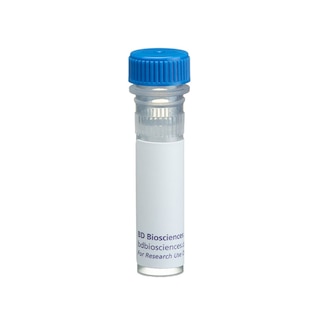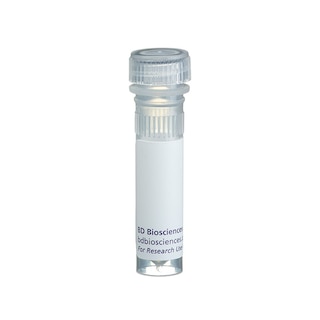-
Reagents
- Flow Cytometry Reagents
-
Western Blotting and Molecular Reagents
- Immunoassay Reagents
-
Single-Cell Multiomics Reagents
- BD® OMICS-Guard Sample Preservation Buffer
- BD® AbSeq Assay
- BD® Single-Cell Multiplexing Kit
- BD Rhapsody™ ATAC-Seq Assays
- BD Rhapsody™ Whole Transcriptome Analysis (WTA) Amplification Kit
- BD Rhapsody™ TCR/BCR Next Multiomic Assays
- BD Rhapsody™ Targeted mRNA Kits
- BD Rhapsody™ Accessory Kits
- BD® OMICS-One Protein Panels
- BD OMICS-One™ WTA Next Assay
-
Functional Assays
-
Microscopy and Imaging Reagents
-
Cell Preparation and Separation Reagents
Old Browser
This page has been recently translated and is available in French now.
Looks like you're visiting us from {countryName}.
Would you like to stay on the current location site or be switched to your location?
BD Pharmingen™ Purified Mouse Anti-Human p16
Clone G175-405 (RUO)

Immunohistochemistry analysis of p16 expression on human breast tissue. A formalin-fixed, paraffin-embedded section from human breast tissue was stained with the Mouse Anti-Human p16 antibody (Cat. No. 550834). Cells expressing p16 were visualized using a three-step staining procedure with Polyclonal Biotin Goat Anti-Mouse Ig (Cat. No. 550337) as the secondary antibody and Streptavidin-HRP (Cat. No. 550946) together with the DAB Substrate Kit (Cat. No. 550880). P16 expression can be identified by the intense brown labeling of cell nuclei (magnification 20X).


Immunohistochemistry analysis of p16 expression on human breast tissue. A formalin-fixed, paraffin-embedded section from human breast tissue was stained with the Mouse Anti-Human p16 antibody (Cat. No. 550834). Cells expressing p16 were visualized using a three-step staining procedure with Polyclonal Biotin Goat Anti-Mouse Ig (Cat. No. 550337) as the secondary antibody and Streptavidin-HRP (Cat. No. 550946) together with the DAB Substrate Kit (Cat. No. 550880). P16 expression can be identified by the intense brown labeling of cell nuclei (magnification 20X).

Immunohistochemistry analysis of p16 expression on human breast tissue. A formalin-fixed, paraffin-embedded section from human breast tissue was stained with the Mouse Anti-Human p16 antibody (Cat. No. 550834). Cells expressing p16 were visualized using a three-step staining procedure with Polyclonal Biotin Goat Anti-Mouse Ig (Cat. No. 550337) as the secondary antibody and Streptavidin-HRP (Cat. No. 550946) together with the DAB Substrate Kit (Cat. No. 550880). P16 expression can be identified by the intense brown labeling of cell nuclei (magnification 20X).



Regulatory Status Legend
Any use of products other than the permitted use without the express written authorization of Becton, Dickinson and Company is strictly prohibited.
Preparation And Storage
Recommended Assay Procedures
Immunohistochemistry: The p16 antibody is recommended to test for immunohistochemical staining on formalin-fixed paraffin-embedded sections. Tissues tested were human breast or colon sections. For paraffin sections, microwave oven pretreatment with BD Retrievagen A (pH 6.0) (Cat. No. 550524) is required. Staining is nuclear and/or cytoplasmic. Yeager et al. found p16 to be both nuclear and cytoplasmic in melanoma. The isotype control recommended for use with this antibody is purified mouse IgG1 (Cat. No. 550878). For optimal indirect immunohistochemical staining, this p16 antibody should be titrated (1:10 to 1:50 dilution) and visualized via a three-step staining procedure in combination with the Polyclonal Biotin Goat Anti-Mouse Ig (Cat. No. 550337) as the secondary antibody and Streptavidin-HRP (Cat. No. 550946) together with the DAB Substrate Kit (Cat. No. 550880). Alternatively, the Anti-Mouse Ig HRP Detection Kit (Cat. No. 551011) offers all the necessary reagents to stain for this antibody.
Product Notices
- Since applications vary, each investigator should titrate the reagent to obtain optimal results.
- An isotype control should be used at the same concentration as the antibody of interest.
- Source of all serum proteins is from USDA inspected abattoirs located in the United States.
- Caution: Sodium azide yields highly toxic hydrazoic acid under acidic conditions. Dilute azide compounds in running water before discarding to avoid accumulation of potentially explosive deposits in plumbing.
- Please refer to http://regdocs.bd.com to access safety data sheets (SDS).
- Sodium azide is a reversible inhibitor of oxidative metabolism; therefore, antibody preparations containing this preservative agent must not be used in cell cultures nor injected into animals. Sodium azide may be removed by washing stained cells or plate-bound antibody or dialyzing soluble antibody in sodium azide-free buffer. Since endotoxin may also affect the results of functional studies, we recommend the NA/LE (No Azide/Low Endotoxin) antibody format, if available, for in vitro and in vivo use.
- Please refer to www.bdbiosciences.com/us/s/resources for technical protocols.
Companion Products






Cyclins and cyclin-dependent kinases (cdks) form active complexes that regulate key events during the progression of the cell cycle and are evolutionarily highly conserved. The p16 protein has been identified as a specific inhibitor of cdk4 because it blocks cdk4 substrate phosphorylation. p16 inhibits cdk4 dependent phosphorylation of the tumor suppressor retinoblastoma protein (Rb) and Rb related proteins, p107 and p130. The biochemical properties of p16 suggest that it may be a tumor suppressor gene product. Recently a gene cloned from the short arm of human chromosome 9, Multiple Tumor Suppressor 1 (MTS1) has been identified as the gene for p16. The gene, now also known as the CDKN2 gene, has been found to be mutated in a very high percentage of tumors, including 75% of melanoma cell lines.
Development References (4)
-
Kamb A, Gruis NA, Weaver-Feldhaus J, et al. A cell cycle regulator potentially involved in genesis of many tumor types. Science. 1994; 264(5157):436-440. (Biology). View Reference
-
Marx J. Link to hereditary melanoma brightens mood for p16 gene. Science. 1994; 265(5177):1364-1365. (Biology). View Reference
-
Serrano M, Hannon GJ, Beach . A new regulatory motif in cell-cycle control causing specific inhibition of cyclin D/CDK4. Nature. 1993; 366(6456):704-707. (Immunogen). View Reference
-
Yeager T, Stadler W, Belair C, Puthenveettil J, Olopade O, Reznikoff C. Increased p16 levels correlate with pRb alterations in human urothelial cells. Cancer Res. 1995; 55(3):493-497. (Clone-specific). View Reference
Please refer to Support Documents for Quality Certificates
Global - Refer to manufacturer's instructions for use and related User Manuals and Technical data sheets before using this products as described
Comparisons, where applicable, are made against older BD Technology, manual methods or are general performance claims. Comparisons are not made against non-BD technologies, unless otherwise noted.
For Research Use Only. Not for use in diagnostic or therapeutic procedures.